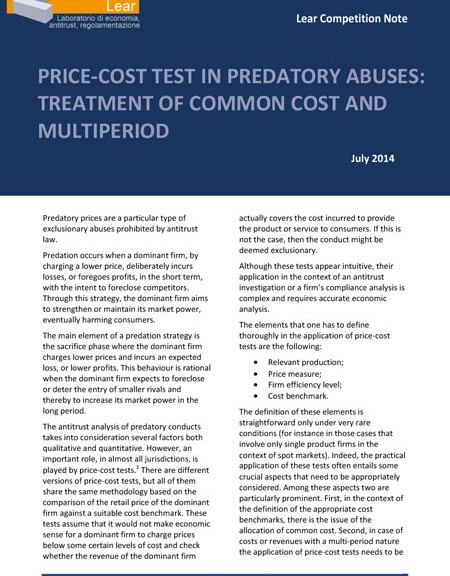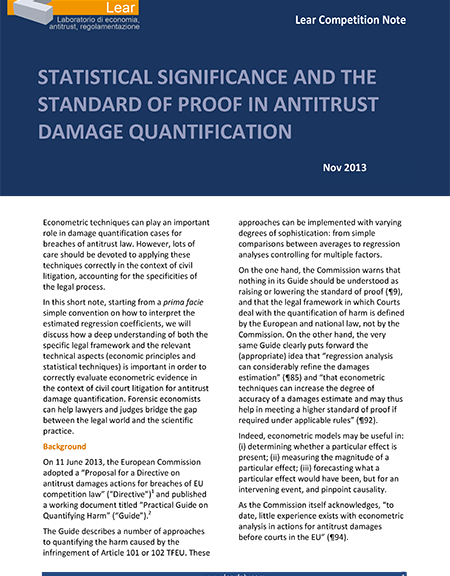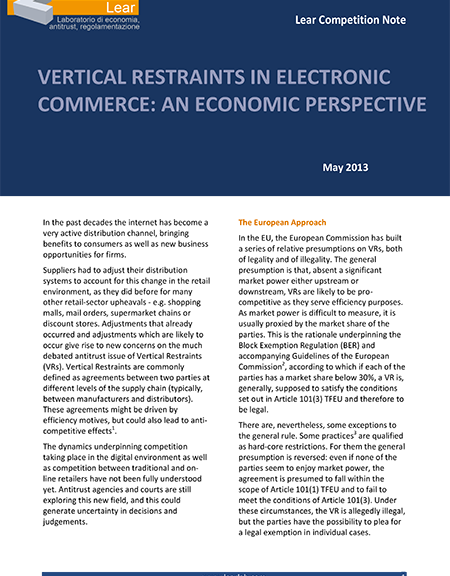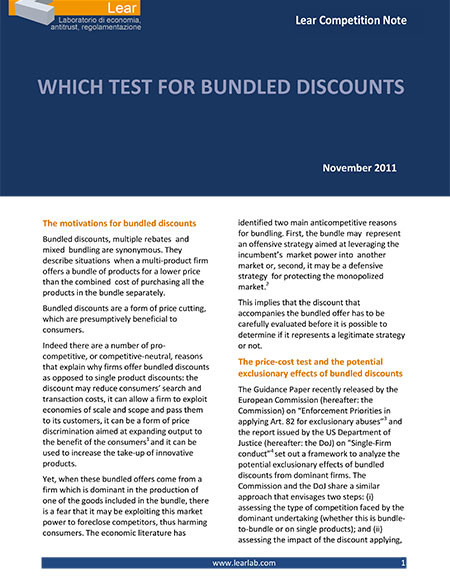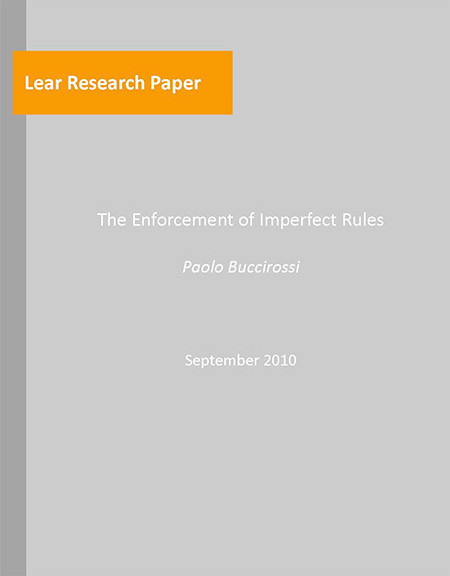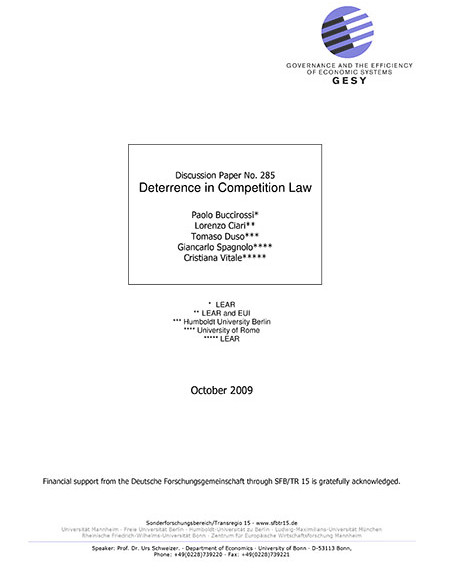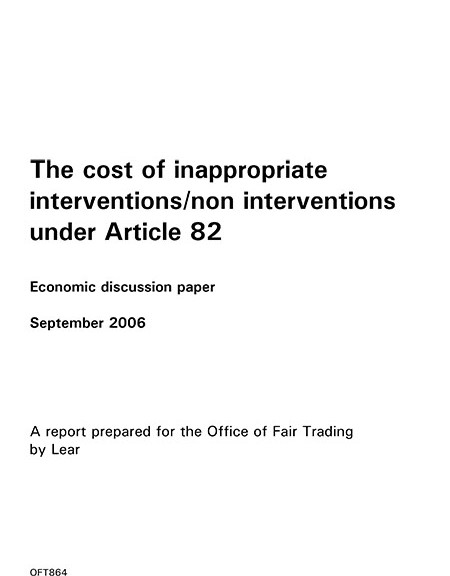This article, jointly written with Analysys Mason, highlights the importance of defining an appropriate counterfactual scenario when quantifying damages arising from an abuse of dominance position by an incumbent operator in the telecoms markets.
Archives
Price-cost test in predatory abuses: treatment of common cost and multiperiod
Predatory prices are a particular type of exclusionary abuse whereby a dominant firm incurs short-term losses by charging a lower price deliberately with the intent to foreclose competitors. The antitrust analysis of predatory conduct entails the application of price-cost tests. These tests are based on the comparison of the retail price of a dominant firm against a suitable cost benchmark. Although these tests appear intuitive, their application in the context of antitrust investigation or of a firm’s compliance analysis is complex and requires accurate economic evaluation. This note describes the crucial aspects that need to be considered in the implementation of the price-cost tests.
Statistical significance and the standard of proof in antitrust damage quantification
Econometric techniques can play an important role in damage quantification cases regarding breaches of antitrust law. In this short note, starting from a prima facie simple convention on how to interpret the estimated regression coefficients, we will discuss how a deep understanding of both the specific legal framework and the relevant technical aspects is important in order to evaluate econometric evidence correctly in the context of civil court litigation for antitrust damage quantification.
Vertical Restraints in Electronic Commerce: an economic perspective
Vertical Restraints (VRs) are commonly defined as agreements between two parties at different levels of the supply chain. These agreements might be driven by efficiency reasons but could also lead to anti-competitive effects. In the past decade, the development of electronic commerce has raised new issues concerning the dynamics underpinning competition in the digital environment as well as competition between traditional and on-line retailers. Through the analysis of the Pierre Fabre Dermo-Cosmétique case, this note seeks to outline a different approach in the assessment of VRs in electronic markets and analyses some critical issues that are often neglected.
Which test for bundled discounts
Bundled discounts are a form of price cutting which are presumptively beneficial to consumers. However, bundle offers from a dominant firm might exploit market power to foreclose competitors, thus harming consumers. The European Commission and the DoJ set out a framework to analyze the potential exclusionary effects of bundled discounts by dominant firms. Focusing on the implementation of the price-cost test, this note discusses two issues that neither the DoJ nor the Commission have addressed so far. Namely, the evaluation of the nature of competition in the relevant markets and the rule to allocate the discount across the products when bundle-to-bundle competition is not possible.
The Enforcement of Imperfect Rules
This paper examines the optimal sanction for rules that are imperfect in that they are either overinclusive, as they prohibit an action that in some circumstances is beneficial, or underinclusive as they allow agents to undertake alternative conducts that are harmful, or both. The paper clarifies why this notion of imperfection divers from the notion of over- and underdeterrence and from that of legal errors. Finally it shows that when rules are imperfect the optimal sanction is lower than the optimal sanction for a perfect rule, both if the rule is overinclusive and if it is underinclusive.
Deterrence in Competition Law
This paper provides a comprehensive discussion of the deterrence properties of a competition policy regime. On the basis of the economic theory of law enforcement we identify several factors that are likely to affect its degree of deterrence: 1) sanctions and damages; 2) financial and human resources; 3) powers during the investigation; 4) quality of the law; 5) separation of power. We then discuss how to measure deterrence. We review independence and 6) the literature that uses surveys to solicit direct information on changes in the behavior of firms due to the threats posed by the enforcement of antitrust rules, and the literature based on the analysis of hard data. We finally argue that the most challenging task, both theoretically and empirically, is how to distinguish between “good” deterrence and “bad” deterrence.
Gesy- Discussion Paper n.285
The cost of inappropriate interventions/non interventions under Article 82
The object of this research produced by the UK Office of Fair Trading (OFT) from LEAR is to improve the understanding of the costs of inappropriate competition authority (non) intervention in cases relating to abuse of dominance. A key aim is a greater understanding of these ‘error costs’ by type of abuse, industry characteristics and form of competition. The research proposes a new taxonomy of potentially abusive conducts and discusses how to asses their welfare effects, so as to minimize the costs of the errors which could be committed by a competition authority.
Published by the OFT (September 2006)
Competition in the Internet Backbone Market
This paper presents a competitive assessment of the global market for the provision of universal Internet connectivity (backbone market). We discuss the approach followed by the EC Commission in two important merger cases. The main argument is for a restless evolution of the structure of the market, whereby an highly concentrated US-centric industry, with a strict vertical hierarchy between Internet Service Providers and a neat separation between first-level ISPs and the rest of the market, is going to be superseded by a more horizontally shaped configuration. It is argued that, as the landscape of the industry is subject to continuous change, the approach followed by the EC Commission in assessing the competitive forces that drive the industry is likely to be no longer appropriate. New behavioral strategies, such as differentiation through the introduction of new enhanced Internet services based on the concept of Quality of Service, and, related to that, new competitive threats seem to characterize the foreseeable future of the Internet. We then investigate the competitive concerns that might emerge in the new environment.
A Search Model Where Consumers Choose Quantity Based on Expected Price
I describe a price game in which consumers face search costs and base their quantity decision on the expected price. Because of search costs, the choice of the firm they will buy from is described by a random process. I show that the expected equilibrium price is above the monopoly price. This result does not change if demand comes from a small share of perfectly informed consumers with zero search costs.
Published in The Journal of Industrial Economics, December 2003, Vol. LI, n. 4, pp. 427-32.


